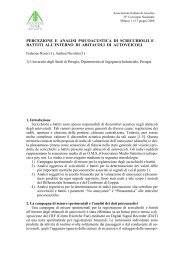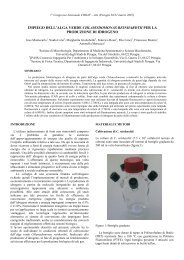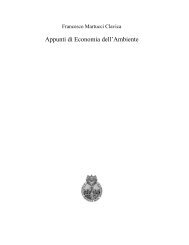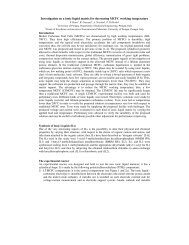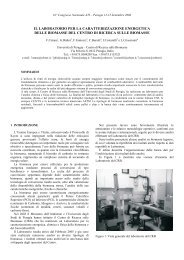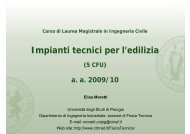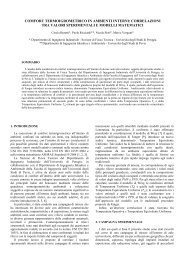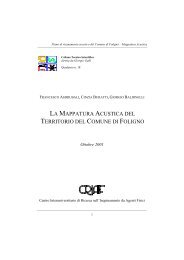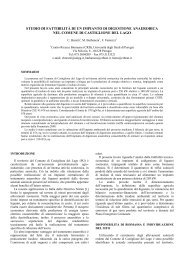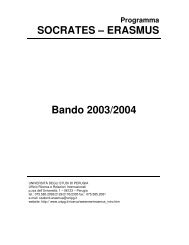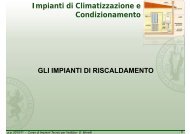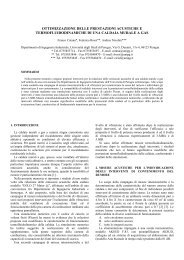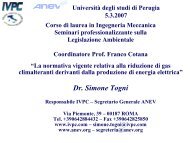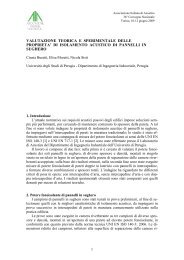comparison among active noise systems for tyre pavement ... - CIRIAF
comparison among active noise systems for tyre pavement ... - CIRIAF
comparison among active noise systems for tyre pavement ... - CIRIAF
Create successful ePaper yourself
Turn your PDF publications into a flip-book with our unique Google optimized e-Paper software.
PACS REFERENCE: 43.50.Ki&203$5,621$021*$&7,9(12,6(6
sustained by a steel frame (item 3 of Figure 1.a) [2]. The <strong>tyre</strong> lies on a plate (item 4 of Figure1.a) the acoustical characteristics of which are equivalent to the road <strong>pavement</strong> ones. Theprototype may be employed to reduce both compression <strong>noise</strong> due to the front end of the <strong>tyre</strong>which superposes the ground and rarefaction <strong>noise</strong> generated by the <strong>tyre</strong> that gives up the<strong>pavement</strong> [4]. Thanks to a custom test bench, measurements allowed to find the prototypeoptimal working conditions: geometry and control unit algorithm. Test bench is constituted by atruncated cone shape steel structure (indicated as 5 in Figure 1.a), which permits to reproducea previously recorded rolling <strong>noise</strong> signal (compression and rarefaction <strong>noise</strong>) at the <strong>tyre</strong><strong>pavement</strong>contact point (item 6 of Figure 1.a) [5].The control unit is based on a FxLMS adaptivealgorithm which is implemented on a DSP. The control unit input signals are: one referencesignal, two microphone error signals. Experimental measures have been carried out by usingthe recorded rolling <strong>noise</strong> as reference signal. Error signal are derived by two microphoneswhich are placed near the <strong>tyre</strong>-<strong>pavement</strong> contact point. One microphone picks up thecompression <strong>noise</strong>, the other picks up the rarefaction <strong>noise</strong>; during experimentalmeasurements, microphones work alternatively. The control unit generates, alternatively, twocontrol signals, one <strong>for</strong> compression <strong>noise</strong>, the other <strong>for</strong> rarefaction <strong>noise</strong>. The block diagramand the prototype mechanical scheme are shown respectively in Figure 1.b and in Figure 2.Control unit processing speed is suitable to instantaneously modify control signal characteristicsin order to keep a 180° phase shift between canceling and rolling <strong>noise</strong> at <strong>tyre</strong>-<strong>pavement</strong>contact point.Control SourceRollingNoiseAmplifierNoisePlayerReferenceSignalNoiseLoudspeakerControlUnitNoise SourceCancellingSignalAmplifierErrorSignalErrorMicrophone(a) Picture of prototype and test benchFigure 1: Prototype n° 1(b) Block diagram352727
BA A’AA’ ViewB’Figure 2: Prototype n° 1 mechanical scheme and measurement pointTable 1: Measurement results. Prototype n° 1, Condition AControl System OFF Control System ON Noise Level ReductionSine wavefrequency(Hz)A-weighted<strong>noise</strong> levelL Aeq[dBA]Equivalent<strong>noise</strong> levelL eq[dB]A-weighted<strong>noise</strong> levelL Aeq[dBA]Equivalent<strong>noise</strong> levelL eq[dB]A-weighted<strong>noise</strong> levelL Aeq[dBA]Equivalent<strong>noise</strong> levelL eq63 65.5 90.0 63.0 84.0 2.5 6.0125 70.5 85.5 66.5 81.0 4.0 4.5250 84.5 92.5 70.0 77.5 14.5 15.0500 90.5 94.0 76.5 79.5 14.0 14.51000 100.0 100.5 98.0 99.0 2.0 1.52000 90.0 88.5 90.0 88.5 0.0 0.04000 69.0 70.0 69.0 70.0 0.0 0.0Table 2: Measurement results. Prototype n° 1, Condition BControl System OFF Control System ON Noise Level ReductionSquarewave maincomponentfrequency(Hz)A-weighted<strong>noise</strong> levelL Aeq[dBA]Equivalent<strong>noise</strong> levelL eq[dB]A-weighted<strong>noise</strong> levelL Aeq[dBA]Equivalent<strong>noise</strong> levelL eq[dB]A-weighted<strong>noise</strong> levelL Aeq[dBA][dB]Equivalent<strong>noise</strong> levelL eq63 78.5 85.0 77.0 81.5 1.5 3.5125 90.5 94.5 83.5 86.5 7.0 8.0250 83.5 83.5 77.0 75.5 6.5 8.0500 86.0 88.5 80.0 80.5 6.0 8.01000 95.0 94.5 93.5 93.5 1.5 1.02000 84.5 83.5 84.5 83.5 0.0 0.04000 77.0 83.0 77.0 83.0 0.0 0.0Table 3: Measurement results. Prototype n° 1, Condition CVehicle Velocity(Km/h)MeasurementPoint[dB]Control System OFF Control System ON Level ReductionMain 1/3 octave bandNoise Equivalent LevelL eqdBBB’ ViewMain 1/3 octave bandNoise Equivalent LevelL eqdBMain 1/3 octave bandNoise Equivalent LevelL eq50 90.5 87.5 3.070 98.0 93.5 4.590 101.5 95.5 6.0110 105.5 99.0 6.5130 107.5 102.0 5.5dB
67$7,&352727
elong to the last DSP generation the processing speed of which is three times higher than thepreviously employed DSP one [6].R.p.s. SensorAcousticalEmitterTyreAcousticalEmitterErrorMicrophoneTyre-PavementPoint Of ContactErrorMicrophoneActiveNoiseControlUnitElectrical MotorRoad Equivalent WheelFigure 5: Dynamical prototype scheme&21&/86,216Two different methods have been proposed to contrast rolling <strong>noise</strong> by means of <strong>active</strong> <strong>noise</strong>control technique. The methods have been proved by realizing two prototypes the workingcondition of which are stationary (not traveling condition); thus a test bench was made up toreproduce a previously recorded rolling <strong>noise</strong>. The first prototype is constituted by a particularacoustical emitter to be installed inside a car mudguard. The second prototype is a cap whichcovers the car <strong>tyre</strong>; inside the cap are logged the canceling <strong>noise</strong> loudspeakers. Both the firstand the second prototype are equipped with a DSP based control unit. A measurementcampaign has shown that the second prototype per<strong>for</strong>ms higher <strong>noise</strong> abatement thank to animproved matching between <strong>noise</strong> and canceling <strong>noise</strong>. However results have alsodemonstrated that rolling <strong>noise</strong> secondary frequency components can not be jet contrastedbecause of a not perfect acoustical matching between rolling and canceling <strong>noise</strong> and a notadequate DSP processing speed. Further experience will be earned thank to another prototypewhich is going to be realized. Such a prototype is a dynamical rolling <strong>noise</strong> generator which canreproduce a pure mechanical rolling <strong>noise</strong> without the affection of the aerodynamic and theengine <strong>noise</strong>s.5()(5(1&(61. B.O. Tretyakov, 7\UH &RPSRQHQWV ,QIOXHQFH RQ 1RLVH, Transport Noise and Vibration 5thInternational Symposium, St. Petersburg, Russia, 6-8 June 2000.2. F. Rossi, F. Cotana, $FWLYH &RQWURO 6\VWHP IRU 7\UHJURXQG &RQWDFW 5ROOLQJ 1RLVH $Q([SHULPHQWDO)DFLOLW\INTER-NOISE 2000, Nice, France, 27-30 August 2000.3. F. Cotana, M. Felli, &RQJHJQR (OHWWURDFXVWLFR SHU OD 5LGX]LRQH GHO 5XPRUH SURGRWWR GDO5RWRODPHQWR GL 3QHXPDWLFL VXOOD 3DYLPHQWD]LRQH 6WUDGDOH H GL 5XRWH )HUUDWH VXL %LQDUL,Ministero dell’Industria e del Commercio e dell’Artigianato, Patent n°. 01297959, 20December 1999, Italy.4. F. Rossi, 7\UHSDYHPHQW 1RLVH $FWLYH &RQWURO 6\VWHP $ /DERUDWRU\ 3URWRW\SH3HUIRUPDQFHV, NOISE-CON 2000, New Port Beach, Cali<strong>for</strong>nia, USA, 3-5 December 2000.5. F. Cotana, C. Buratti, ,QGDJLQH 6SHULPHQWDOH VXO 5XPRUH 6WUDGDOH GD 5RWRODPHQWR 27thCongresso Nazionale AIA, Genoa, Italy, 26-28 May 1999.6. Analog Devices, $'63[6+$5&8VHUV0DQXDO, May 1997.



